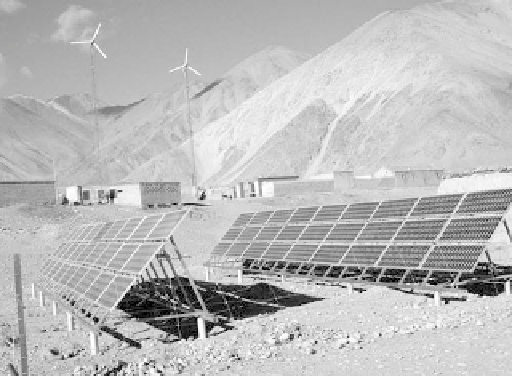Environmental Engineering Reference
In-Depth Information
FIGURE 12.3
Hybrid (wind/PV/diesel) renewable village power system for Subashi, Xinjiang Province,
China. (Photo by Charlie Dou. With permission.)
At Ascension Island, the simple payback was estimated to be 7 years for the addition of two
900 kW wind turbines in a high-penetration system. This saves an additional 2,400,000 L of die-
sel per year, and for diesel at $1.50/L that would be $3,600,000/year, and so the simple payback
would be around 3 years. Most wind-diesel systems will not be this dramatic. High-penetration
systems will also save on diesel maintenance, since the diesel gensets will not operate as many
hours.
The three 100 kW wind turbines produce around 675,000 kWh/year as part of a wind-diesel
plant at Toksook Bay, Alaska. The wind turbines displace 196,000 L of diesel per year, and if the
cost of diesel at bulk price is $1.50/L, or even more, that produces a savings of $300,000 per year.
If the installed cost for the wind turbines was around $1,500,000, then the simple payback would be
5 years. In May 2008, bid price for bulk diesel in remote Alaska was as high as $1.90/L.
At St. Paul Island, Alaska, the installed cost was $905,000 ($ 1999) for a wind-diesel system [16]
that provided power to an industrial complex (no grid). The high-penetration, no-storage system
consisted of one wind turbine, 225 kW, and two 150 kW diesel generators. The cost of energy from
the system was $0.15/kWh, compared to diesel grid costs of $0.43/kWh ($ 2004). Since then, two
more wind turbines have been added to support economic development and to generate enough
power for residential consumption.
Costs for renewable village power systems vary widely, as most systems are components from
different suppliers and manufacturers, and of course are located in remote locations. The best exam-
ple is China's SDDX project (2002-2005), which consisted of 721 PV, wind, and PV/wind renew-
able village power systems (15,540 kW), 292 small hydro stations (113,765 kW), and 15,458 small
single-household units (1,103 kW) with an installed capacity of 130,408 kW (see
Table 10.7
). The
total investment was 4.7 * 10
9
Yuan (~$570 million), or an average of $4,370/kW [17, chap. 6].
The cost was $178,000 for one village hybrid system (Figure 12.3) in a remote region of China
($ 2003). This included everything from power generation to the mini grid transmission lines. The
configuration is two 10 kW wind turbines, 4 kW PV, 30 kVA diesel, 1,000 Ah battery bank, and
a 38 kVA DC-AC inverter. At 54 kW the installed cost was $3,300/kW, which is very reasonable
for a remote location. The renewable part of the system produces around 150 kWh per day. The
unknowns in calculating the cost of energy are percent of the energy supplied by the diesel genera-
tor, cost of diesel fuel, levelized replacement costs, and operation and maintenance. A known major
cost is that the battery bank will be replaced every 5 to 7 years.

Search WWH ::

Custom Search